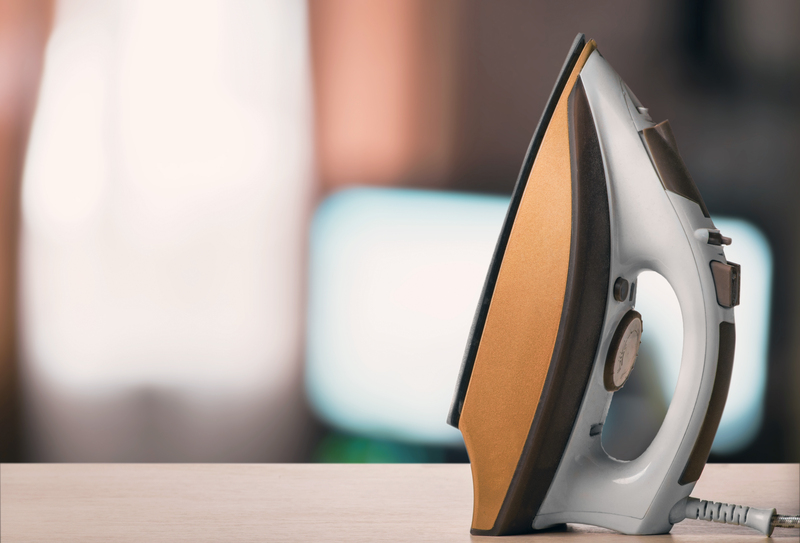Banish Grease: Effortless Ways to Clean Enamel Oven Trays
Posted on 21/05/2025
Banish Grease: Effortless Ways to Clean Enamel Oven Trays
Are you tired of stubborn grease and baked-on grime ruining your enamel oven trays? If so, you're not alone. This kitchen accessory is a true workhorse, but with frequent use comes grease, stains, and burnt food debris that can seem impossible to remove. But don't worry--you can reclaim your trays' pristine shine without hours of scrubbing or harsh chemicals. In this comprehensive guide, we'll show you the easiest, most effective, and safest methods to banish grease and keep your enamel trays sparkling clean.
Understanding Enamel Oven Trays
Before diving into cleaning techniques, it's essential to understand what makes enamel oven trays unique. These trays are typically steel or iron coated with a layer of smooth, glossy enamel. This coating is non-porous, resistant to rust, and designed to withstand high temperatures. However, the enamel surface, while durable, requires specific care to prevent chipping or dulling.
- Heat Resistant: Enamel trays can handle high-oven temps without warping or discoloration.
- Non-Stick Qualities: While not as slick as Teflon, enamel offers some resistance to sticking.
- Easy to Clean: The smooth surface resists most stains, making cleaning easier when done right.
- Important: Abrasive tools can scratch or damage the enamel, shortening its lifespan.

Common Causes of Grease Buildup on Enamel Trays
Food particles, splattering oils, and sugary drips are common culprits behind that stubborn buildup on your enamel oven trays. Over time, layers of grease can burn onto the surface, leading to tough, baked-on stains that refuse to budge. Understanding these causes is your first step toward preventing grime from becoming unmanageable.
- Cooking at High Temperatures can rapidly bake grease onto the enamel surface.
- Thick, Sugary Sauces (like BBQ) tend to caramelize and harden onto the tray.
- Spills and Overflows create sticky, resilient messes.
- Skipping Immediate Cleanup allows food residue to solidify and become even tougher to remove.
Easy, Safe Ways to Clean Enamel Oven Trays
Let's unveil the best methods to clean enamel oven trays and remove even the most stubborn baked-on grease--without damaging that precious enamel surface.
1. The Power of Hot Soapy Water
- Step 1: Allow the tray to cool completely after use. Never immerse a hot tray directly in cold water; this can cause warping or cracking.
- Step 2: Fill your sink with hot water and generous dishwashing liquid.
- Step 3: Let the tray soak for 30 minutes to an hour. Soaking loosens grease and food debris.
- Step 4: Use a soft sponge or non-abrasive brush to gently scrub away the softened mess.
- Step 5: Rinse thoroughly and dry with a soft towel.
Tip: For lingering greasy spots, add a splash of vinegar to the dish water for an extra degreasing boost.
2. Bicarbonate of Soda and Vinegar Paste
If hot, soapy water isn't enough to remove tough grime from enamel oven trays, try a baking soda and vinegar paste. This chemical reaction helps break down grease without scratching surfaces.
- Sprinkle a generous layer of baking soda over the tray, especially on sticky spots.
- Lightly mist or sprinkle white vinegar over the baking soda. It will fizz and foam--this is perfectly normal!
- Allow the mixture to sit for 10-15 minutes. The fizzing action helps lift stuck-on residue.
- Gently scrub using a soft-bristled brush or sponge. Never use steel wool or abrasives!
- Rinse thoroughly with clean water and dry with a lint-free cloth.
3. Harness Lemon Power for Natural Cleaning
Lemon juice is a fantastic natural cleaner. The acidity helps dissolve grease and leaves your tray smelling fresh.
- Step 1: Cut a lemon in half and squeeze the juice over the soiled tray.
- Step 2: Sprinkle a little salt over stubborn stains (the salt acts as a gentle abrasive).
- Step 3: Use the cut side of the lemon as your scrubber, working it over the tray in circular motions.
- Step 4: Let the mixture sit for 10-20 minutes, then rinse with warm water and dry.
4. Commercial Oven Cleaner (For Extreme Cases)
Warning: Only use enamel-safe, non-abrasive commercial cleaners specifically labeled for enamel cookware. Always follow manufacturer instructions and wear gloves to protect your skin.
- Spray or apply the oven cleaner over the greasy areas.
- Let the product sit for the manufacturer-recommended time--usually 15-30 minutes.
- Wipe away loosened grease with a damp cloth or sponge.
- Thoroughly rinse the tray before its next use to ensure no chemical residue remains.
Pro Tips to Keep Enamel Oven Trays Looking Like New
Regular maintenance goes a long way to prevent grease buildup and keep cleaning hassle-free. Here's what you can do:
Routine Cleaning is Key
- Always wash trays as soon as they've cooled after use. The longer grease sits, the harder it is to remove.
- Try to avoid putting extremely dirty (or burnt-on) trays straight into the dishwasher--hand washing is often gentler and more effective for spot treating stains.
Line Your Trays for Easy Cleaning
- Use parchment paper, silicone mats, or aluminum foil when roasting or baking. These act as a barrier and prevent stubborn stains from reaching the tray.
- For very greasy bakes (like roasting meats), double up on liners or use a roasting rack positioned above the tray.
Never Use Abrasive Tools
- Metal scouring pads, steel wool, or harsh scrapers can scratch and chip enamel, causing it to wear out prematurely.
- Stick to soft sponges, nylon brushes, or microfiber cloths to ensure the enamel coating stays intact.
Periodic Deep Cleans
- Even with regular care, occasionally deep clean your enamel trays using the baking soda and vinegar paste or lemon-salt method.
- Always inspect trays for damage. If you notice chips or cracks in the enamel, discontinue use; damaged enamel exposes the metal to rust and corrosion.
Best Practices: What to Avoid When Cleaning Enamel Oven Trays
- No Bleach: Bleach can discolor and weaken enamel, leading to dull or damaged trays.
- No Preheating Empty: Heating an empty, dry enamel tray in a hot oven may cause it to crack.
- No Sudden Temperature Changes: Allow the tray to cool before immersing in water to prevent thermal shock.
- No Prolonged Soaking: Although brief soaking helps loosen grime, extended soaking can allow water to seep under chips, leading to rust on hidden metal surfaces.
Troubleshooting: Stubborn Stains & Burnt-On Grease
Despite your best efforts, sometimes super tough stains don't budge. Here's what to do:
Use a Baking Soda Poultice
Make a thick paste with baking soda and a few drops of water. Slather it over the stain, cover with plastic wrap, and leave it to sit overnight. Wipe away with a soft cloth--most stains will lift easily by morning.
Try Hydrogen Peroxide for White Enamel
For white enamel trays (not colored!), a mix of hydrogen peroxide and baking soda can help lift discoloration. Test in a small area first; avoid using this method on colored/glazed enamel as it can lighten the color.
Repeat The Process
In some cases, it may take two or three rounds of cleaning to completely remove burnt-on food or grease. Be patient--avoiding harsh abrasives ensures your enamel tray's longevity.
How to Store and Maintain Your Enamel Oven Trays
- Ensure trays are completely dry before storing to avoid trapping moisture, which can lead to rust under chips or at seams.
- Store upright or with soft padding between trays to prevent chipping.
- Inspect periodically for any cracks, chips, or signs of wear. Replace trays that are significantly damaged for food safety.
- Avoid stacking heavy items on top, especially other pans or baking equipment, as this puts stress on the enamel coating.

Frequently Asked Questions About Cleaning Enamel Oven Trays
Can I put enamel oven trays in the dishwasher?
Yes, most enamel trays are labeled dishwasher-safe. However, for best results and stain prevention, wash by hand, especially after greasy or burnt-on messes. Harsh dishwasher detergents can dull the enamel over time.
Is it safe to use oven cleaner on enamel trays?
Only if the oven cleaner specifically says it's safe for enamel. Always spot-test before doing a full clean, and rinse thoroughly to remove all traces of chemicals.
Why does burnt-on grease keep coming back?
Grease re-bakes onto the tray if it's not completely removed or if you frequently roast oily foods. Using baking soda, vinegar and regular cleaning will help break the cycle.
How to remove rust from an enamel tray?
If rust appears, it's likely the enamel is chipped. Gently clean away rust with a baking soda paste, but discontinue use if rust is extensive. Exposed metal can leach into food and is a sign it's time to replace the tray.
Conclusion: Effortless Oven Tray Cleaning is Within Reach!
Banish baked-on grease from your enamel oven trays for good with these simple, proven methods. Whether you prefer soaking, natural cleaners like lemon and vinegar, or smart preventive habits, you can keep your trays as shiny and spotless as the day you bought them. Remember: gentle tools, regular care, and a little patience go a long way. The effortless way to clean enamel oven trays is at your fingertips--your sparkling kitchen awaits!
Now that you've mastered how to banish grease on enamel oven trays, share these tips and help others achieve spotless trays, too!
```


